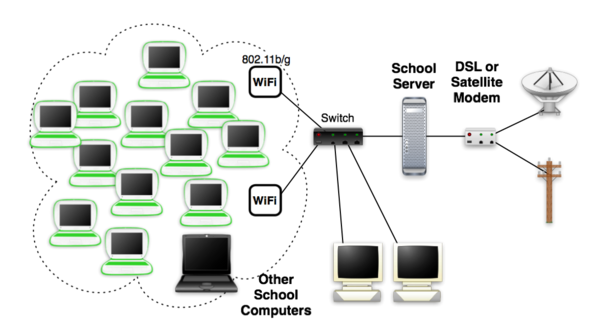XS Installing Software 0.7
| Please copy/paste "{{Translationlist | xx | origlang=en | translated={{{translated}}}}}" (where xx is ISO 639 language code for your translation) to XS Installing Software 0.7/translations | HowTo [ID# 266033] +/- |
This page describes how to obtain a copy of the XS school server software, load it onto media, and install it onto a system.
This page covers XS 0.7 and newer. For older releases, see
Downloading the System Image
You can obtain the latest image from http://dev.laptop.org/xs/:
wget http://dev.laptop.org/xs/OLPC_XS_LATEST.iso
This can be copied onto a CD or DVD using your favorite software.
You can also install it from USB (warning: unsupported!)
Installing the Software
Please read the release notes for the version you are installing.
The install from a CD or USB storage device will eventually be automatic upon booting. While the install is currently mostly automated (not interactive), it is not performed automatically upon boot.
- Boot from the USB device or CD-ROM.
- Press enter to start the graphical boot menu.
- Select "Install using kickstart" at the initial boot screen.
- "Install using kickstart" is the last menu item. Do not use the other "Install" options on this menu as they only install Fedora 9 without the olpc scripts. The Anaconda installer will install around 546 packages. If it announces it is installing 407 packages, the olpc scripts are missing. Start again.
- Note: the default graphical installer can be unstable at times. You can press tab and add 'text' at the end of the line to request the text-based installer.
- Anaconda (the Fedora installer) takes over and you will be prompted for the standard questions - these are preset to the correct defaults for the School Server configuration. You will want to set keyboard type, the time zone, and a root password for your specific system.
- If you are planning to deploy to a large number of XSs, it is easy to modify the Kickstart file to have the whole process run automatically.
- When prompted to add specific packages, just leave the default and click next.
- When it has finished installing, you will be prompted to reboot. Remove the CD-ROM or USB device after power-down, but before the boot process begins.
You should now have a School Server! It needs initial configuration before it starts providing services to the laptops.
Initial Configuration
Setting hostname and domain
Login as root, with whatever password you assigned during installation.
Right after installation, you must
- Set the server domain name (the hostname is always 'schoolserver') using:
/etc/sysconfig/olpc-scripts/domain_config example.org
- Reboot the machine so the hostname change can take effect:
reboot
- Installation and initial configuration are complete!
What next?
Important: Register an XO and visit the Schoolserver. You should do this with the XO of a teacher or school principal, as the first XO to visit the Schoolserver will have the "course creator" role. More about Moodle
All the topics below are discussed in XS Techniques and Configuration
- Setting a static IP address for eth0, or using something other than eth0 as your WAN port.
- Using specific DNS servers (from your ISP, or from OpenDNS -recommended!)
- You may want to enable the transparent HTTP proxy.
- and more...
Network Configuration Notes
The default server setup is to connect to the Internet on the first wired ethernet network interface, using IPv4 DHCP. Laptops connect to the server over Access Points (APs) connected to the second wired ethernet network interface or via the wireless mesh using one or more Active Antenna, connected through USB interfaces.
If your XS has 2 network interfaces and you would like to reverse their (WAN, LAN) roles, or if you only have one network interface and would like to swap it's role, you can use the xs-swapnics utility. If you get your WAN via some other interface (e.g., ppp0) then you will want to see the recipes for WAN connections.
IPv6 is not enabled by default and not needed -- to enable external IPv6 you will have to configure the global address of the machine and setup an IPv6 tunnel.
The XS runs a fully-fledged DNS server internally, therefore there is no need to enter the DNS servers from your ISP into the configuration. If you do want the XS to use specific DNSs, see the instructions on using ISP-provided DNS servers
Access Points
Most access points are compatible with the XO. For a list of ones which have been shown to work see Wireless Access Point Compatibility. Unless a single access point is being used (not recommended for more than forty to fifty laptops), a network switch of some sort will also be needed.
Make sure your AP is configured to act as an Access Point, with no added features or smarts. The AP should not be a DHCP server and should not act as a router.
Some tips on configuring APs at XS_Techniques_and_Configuration.
More configuration options
For more information on keeping your XS up to date, Internet content filtering, alternative networking/routing setups, and a lot of other advanced configuration topics see XS_Techniques_and_Configuration.
